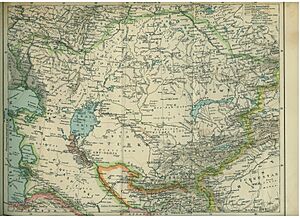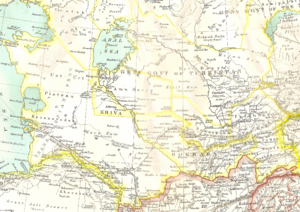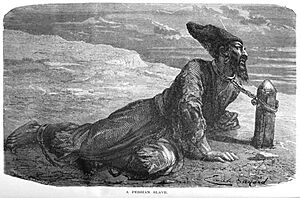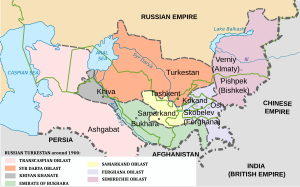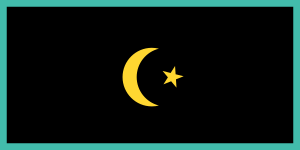Khanate of Khiva facts for kids
Quick facts for kids
Khanate of Khiva
|
|||||||||
|---|---|---|---|---|---|---|---|---|---|
| 1511–1920 | |||||||||
|
Flag of Khiva (1917–1920)
|
|||||||||
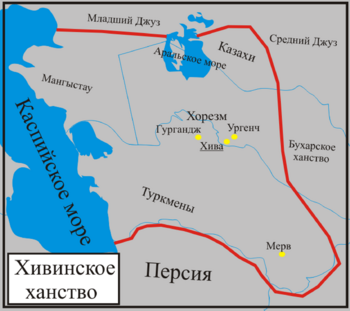
The Khanate of Khiva (bordered in red), c. 1700.
|
|||||||||
| Status |
|
||||||||
| Capital | Khiva | ||||||||
| Common languages | |||||||||
| Religion | Sunni Islam | ||||||||
| Government | Absolute hereditary monarchy | ||||||||
| Khan | |||||||||
|
• 1511–1518
|
Ilbars I (first) | ||||||||
|
• 1918–1920
|
Sayid Abdullah (last) | ||||||||
| History | |||||||||
|
• Established
|
1511 | ||||||||
|
• Afsharid conquest
|
1740 | ||||||||
|
• Qungrad dynasty est.
|
1804 | ||||||||
|
• Russian conquest
|
12 August 1873 | ||||||||
|
• Disestablished
|
2 February 1920 | ||||||||
| Area | |||||||||
| 1911 | 67,521 km2 (26,070 sq mi) | ||||||||
| Population | |||||||||
|
• 1902
|
700,000 | ||||||||
|
• 1908
|
800,000 | ||||||||
|
• 1911
|
550,000 | ||||||||
|
|||||||||
| Today part of | |||||||||
The Khanate of Khiva was a powerful country in Central Asia that lasted for a long time, from 1511 to 1920. Its capital city was Khiva. This state was located in a historical region called Khwarazm.
The Khanate covered parts of what are now western Uzbekistan, southwestern Kazakhstan, and much of Turkmenistan. For a short period, from 1740 to 1746, it was taken over by the Afsharid Empire, led by Nader Shah.
In 1873, the Khanate of Khiva became much smaller. It then became a Russian protectorate. This meant Russia protected and controlled it. This arrangement lasted until the Russian Revolution of 1917. After a local revolution in 1920, the Khanate was replaced by the Khorezm People's Soviet Republic. In 1924, this area became part of the Soviet Union. Today, it is mostly part of Uzbekistan and Turkmenistan.
Contents
What Was the Khanate of Khiva?
The name "Khanate of Khiva" became popular because of Russian historians. They named it after its capital city, Khiva. However, the people who lived there usually called their country vilayet Khwārazm. This means "country of Khwarazm."
Before the 1600s or 1700s, the state was often called "Urgench." This was because its capital was originally in a city called Konye-Urgench.
A Look Back: History of Khiva
Early Times and New Beginnings
The region of Khwarazm has a very long history. Before 1505, it was part of the Timurid Empire. Then, a powerful leader named Muhammad Shaybani took over Khwarazm in 1505.
Soon after, in 1510, Shah Ismail I of Persia fought and defeated Muhammad Shaybani. Shah Ismail's army briefly took control of Khwarazm. However, the local people resisted because of his different religion. In 1511, they kicked out the Persian soldiers. Power then went to Ilbars, who started a new ruling family called the Arabshahid dynasty.
Around the year 1600, a major river branch called the Daryaliq dried up. This caused the capital city to move south from Konye-Urgench to Khiva. This is how the state became known as the Khanate of Khiva.
Life in the Khanate
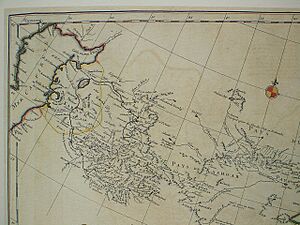
The Khanate was located near the Amu Darya river, south of the Aral Sea. It usually controlled most of what is now Turkmenistan. The people living there were mostly farmers along the river. Other groups were nomadic, meaning they moved around.
The settled population included nobles and farmers. Over time, many Uzbeks moved into the area from the north. Their Turkic languages slowly became what is now the Uzbek language. The original Iranian language of Khwarazm disappeared. The swampy areas were settled by Karakalpaks, and Kazakhs lived as nomads on the northern border.
The Turkmen nomads paid taxes to the Khan. They were also a big part of his army. However, they often rebelled against the Khan's rule. The Khanate was surrounded by semi-desert. So, the easiest way to attack it was along the Amu Darya river. This led to many wars with the Khanate of Bukhara, another state located further up the river.
Some important Khans ruled during this period. Abu al-Ghazi Bahadur (1643–1663) was a famous Khan. He defeated the Kalmyks twice. He also wrote an important history book about Central Asia. His son, Anusha (1663–1685), saw a period of growth in the cities.
In 1740, Nadir Shah of Persia conquered Khiva. He executed the Khan, Ilbars II. After Nadir Shah's death in 1747, the Qongrat tribe became very powerful. They started appointing Khans who were mostly figureheads. In 1804, Iltuzar Khan officially started the Qongrat dynasty. The Khanate became strong again under Muhammad Rahim Khan (1806–1825) and Allah Quli Khan (1825–1840).
Russian Influence and Control
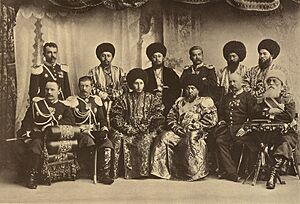
Russia tried to conquer Khiva several times. In 1717, a Russian army led by Alexander Bekovich-Cherkassky attacked Khiva. They won a battle. But the Khan tricked them into spreading out. Then he had them all killed or captured. Only a few Russians survived to tell the story.
Another Russian attack in 1839, led by Perovsky, failed. This was because of extremely cold weather. Many soldiers and camels were lost. One reason for Russia's interest was the number of Russian people held captive in Khiva. Britain also tried to help free these captives. In 1840, a British officer named Richmond Shakespear convinced the Khan to free all Russian captives. He also made it a crime punishable by death to hold Russian captives. This removed Russia's main reason for attacking Khiva for a while.
However, Russia's military power in Central Asia grew. In 1873, after taking major cities like Tashkent and Samarkand, General Konstantin Petrovich Von Kaufman launched a big attack on Khiva. The city of Khiva fell on June 10, 1873. On August 12, 1873, a peace treaty was signed. This treaty made Khiva a vassal state, or a "protectorate," under Russian control. This conquest also ended the practice of holding captives in Khiva.
After Russia conquered the rest of what is now Turkmenistan in 1884, the Khanates of Khiva and Bukhara were completely surrounded by Russian territory.
In 1882, a group of Mennonites (a Christian religious group) from Germany settled in Khiva. They helped modernize the Khanate before the Russian Revolution. They introduced photography, better ways to harvest cotton, and electrical generators.
The End of the Khanate
After the 1917 Bolshevik revolution in Russia, groups against the Khan and Turkmen tribes joined forces with the Bolsheviks. In late 1919, they worked together to remove the Khan from power. By early February 1920, the Khivan army, led by Junaid Khan, was completely defeated.
On February 2, 1920, Sayid Abdullah, the last Khan of Khiva, gave up his rule. The territory of the old Khanate of Khiva was then replaced by a new state. This was called the Khorezm People's Soviet Republic. This republic was later fully taken into the Soviet Union in 1924. The former Khanate's land was divided between the new Turkmen and Uzbek Soviet Republics.
After the Soviet Union broke apart in 1991, these areas became the independent countries of Turkmenistan and Uzbekistan. Today, the land that was once the Khanate of Khiva has a mixed population. This includes Uzbeks, Karakalpaks, Turkmens, and Kazakhs.
Khans of Khiva (1511–1920)
The rulers of Khiva were called Khans. Here are the main ruling families that led the Khanate:
Arabshahid Dynasty (1511–1804)
This was the first long-lasting ruling family of Khans. It was started by Ilbars I. Many Khans from this family ruled Khiva for nearly 300 years. Some important Khans include:
- Ilbars I (1511–1518): He was put in power by the local people. He fought to drive out the Persians.
- Abu al-Ghazi Bahadur (1643–1663): A famous Khan who fought against invaders. He also wrote important historical books.
- Shir Ghazi (1714–1727): He defeated a Russian attack. But he was later killed by his own captives.
- Ilbars II (1728–1740): He was executed by Nadir Shah when the Persians conquered Khiva.
After 1747, the Khans from this family became less powerful. The real power was held by leaders from the Qongrat tribe.
Qungrat Dynasty (1804–1920)
The Qongrat tribe eventually took full control. Their leader, Eltuzar-Inak, declared himself Khan in 1804. This started a new ruling family.
- Eltuzar-Inak (1804–1806): The first Khan of the Qungrat dynasty. He drowned during a battle.
- Muhammad Rahim Bahadur I (1806–1825): He brought order back to the Khanate. He also conquered new areas.
- Allah Quli Bahadur (1825–1842): During his rule, the Khanate expanded. He also faced the failed Russian invasion of 1839.
- Muhammad Rahim Bahadur II (1864–1910): He was the Khan when Russia conquered Khiva in 1873. Khiva then became a Russian protectorate under his rule.
- Isfandiyar Jurji Bahadur (1910–1918): He lost control of the country to a Turkmen leader. He was executed.
- Sayid Abdullah (1918–1920): He was the last Khan of Khiva. Real power was held by Junaid Khan. He gave up his rule in 1920, ending the Khanate.
See also
- Khiva
- Khorezm People's Soviet Republic
- Khwarazm
Images for kids



